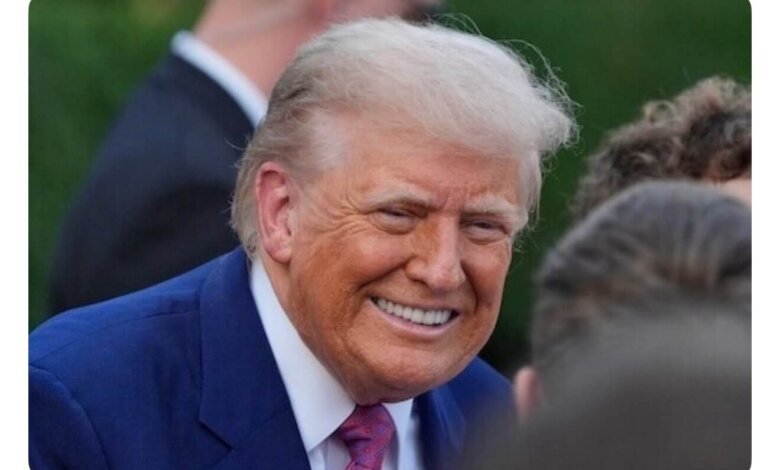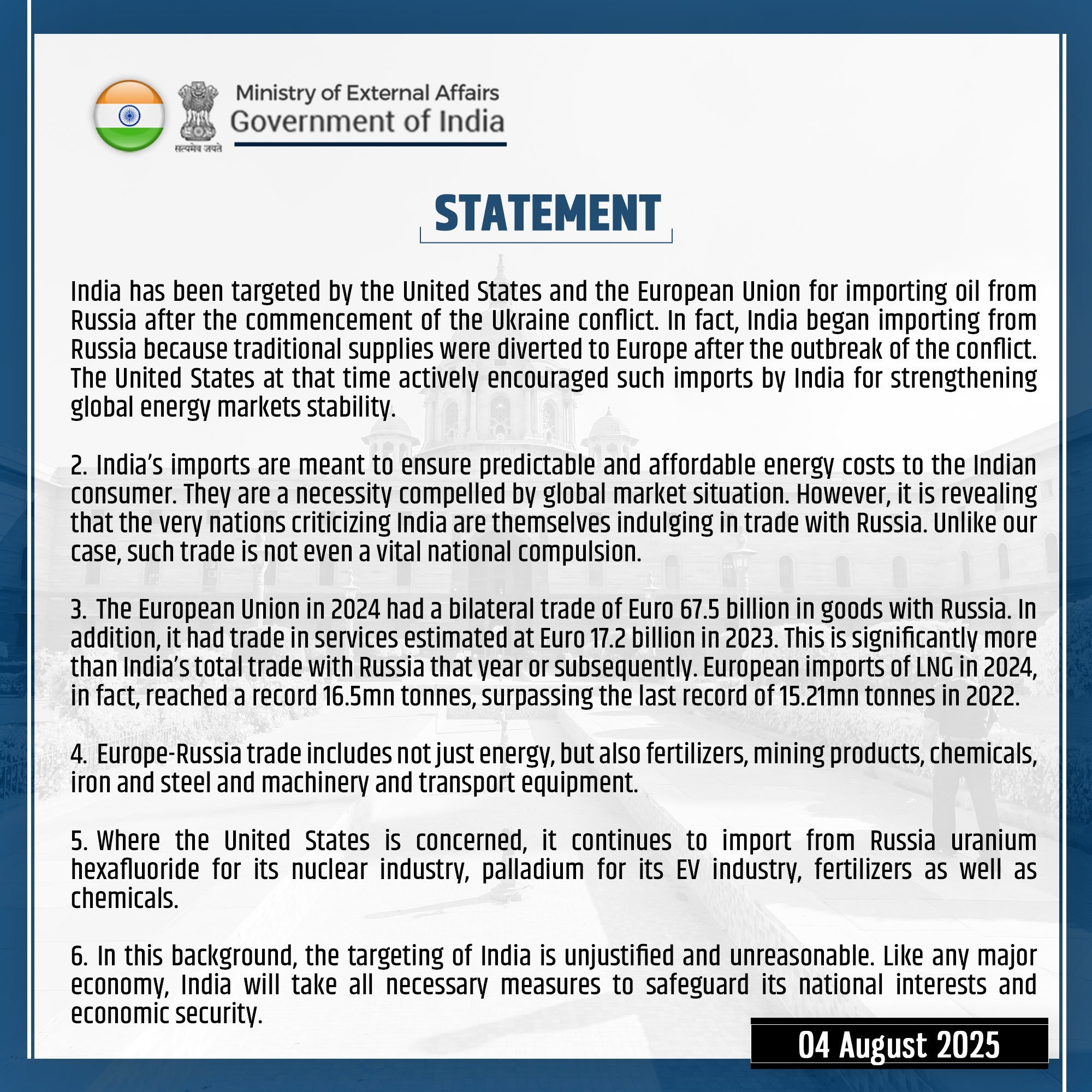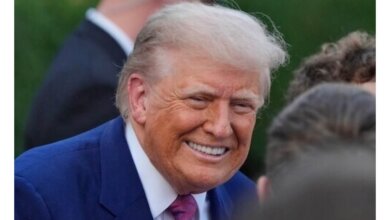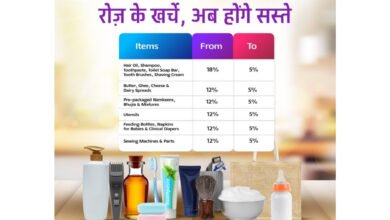India Responds to Trump’s Tariff Threat Over Russian Oil Trade

New Delhi: Tensions between the United States and India escalated today as U.S. President Donald Trump announced plans to impose steep tariffs on Indian goods, citing India’s trade in Russian oil. In a fiery post on Truth Social, Trump accused India of profiting from the Russia-Ukraine conflict by purchasing and reselling Russian oil, claiming that India shows indifference to the ongoing war in Ukraine. India swiftly countered with a detailed rebuttal on the social media platform X, defending its energy policies and accusing Western nations of hypocrisy.
Trump’s Truth Social Post Sparks Controversy
In his Truth Social post on August 4, 2025, President Trump stated, “India is not only buying massive amounts of Russian Oil, they are then, for much of the Oil purchased, selling it on the Open Market for big profits. They don’t care how many people in Ukraine are being killed by the Russian War Machine. Because of this, I will be substantially raising the Tariff paid by India to the USA.” The post, which concluded with Trump’s signature “Thank you for your attention to this matter!!! President DJT,” also reiterated his earlier criticisms of India’s high tariffs and trade barriers, labeling the Indian economy as “dead” in previous posts.
This announcement follows Trump’s July 30 declaration of a 25% tariff on Indian imports starting August 1, coupled with an unspecified “penalty” for India’s purchases of Russian oil and military equipment. The move has strained ongoing trade negotiations, which both nations hoped would culminate in a mutually beneficial agreement by the end of 2025.
India’s Response: A Pointed Defense
India’s Ministry of External Affairs responded on X, issuing a six-point statement that firmly rejected Trump’s accusations and highlighted inconsistencies in U.S. and European trade practices. The statement explained that India began importing Russian oil after the Ukraine conflict disrupted traditional supplies, which were diverted to Europe. “India’s imports are meant to ensure predictable and affordable energy costs to the Indian consumer. They are a necessity compelled by global market situation,” the ministry stated, emphasizing that these imports were initially encouraged by the U.S. to stabilize global energy markets.
India further pointed out that the European Union’s 2024 trade with Russia totaled €67.5 billion in goods and €17.2 billion in services, with record-high LNG imports of 16.5 million tonnes. The U.S., too, continues to import critical materials like uranium hexafluoride and palladium from Russia. “The very nations criticizing India are themselves indulging in trade with Russia. Unlike our case, such trade is not even a vital national compulsion,” India’s statement read, calling the targeting of India “unjustified and unreasonable.” The ministry concluded by affirming India’s commitment to safeguarding its national interests and economic security.

Economic and Diplomatic Implications
Trump’s tariff threats come at a critical juncture for U.S.-India relations, which had been bolstered by a shared strategic interest in countering China and strengthening the Quad alliance. However, his recent posts, including a July 31 Truth Social message stating, “I don’t care what India does with Russia. They can take their dead economies down together,” have sparked alarm in New Delhi. Indian officials, including Commerce Minister Piyush Goyal, have dismissed Trump’s claim that India’s economy is “dead,” noting that India is the world’s fastest-growing major economy and is projected to become the third-largest by 2030.
The 25% tariff, combined with an ambiguous penalty, could disrupt key Indian export sectors such as pharmaceuticals, textiles, and automobiles. Indian shares fell on July 31, with the Nifty 50 dropping 0.61% and the BSE Sensex declining 0.64%, reflecting market concerns. Experts warn that sustained tariffs could pose a headwind to India’s GDP growth, though the extent depends on the penalty’s details.
Western Trade with Russia Under Scrutiny
India’s response on X highlighted the hypocrisy of Western nations criticizing its Russian oil imports while maintaining their own trade ties with Moscow. The EU’s significant trade volume with Russia, including energy, fertilizers, and chemicals, and the U.S.’s continued imports of strategic materials undermine their moral posturing, India argued. This stance has resonated on X, with users like @thegeo_sync stating, “India doesn’t need lectures from someone whose own allies still import Russian energy. Europe buys Russian LNG — why single out India?”
Ongoing Trade Talks and Future Outlook
Despite the escalating rhetoric, both nations continue trade negotiations, with U.S. officials expected to visit India later in August for the sixth round of talks. India remains committed to securing a “fair, balanced, and mutually beneficial” trade deal, as stated by the Ministry of Commerce. However, Trump’s aggressive stance, including his suggestion that Pakistan could one day sell oil to India, has cast a shadow over the talks, with analysts noting that trust has diminished.
Indian trade bodies, such as the Medical Technology Association of India, have called Trump’s tariffs “economically shortsighted and strategically misguided,” warning of potential job losses and higher prices for U.S. consumers. Meanwhile, opposition leaders in India, including Congress MP Imraan Masood, have criticized the government’s diplomacy, arguing that it has failed to counter U.S. pressure effectively.
As the August 8 deadline for Trump’s proposed Russian sanctions approaches, the global economic landscape remains tense. India’s firm stance on its sovereign right to source energy and its call for equitable treatment in trade relations signal a broader push for economic autonomy amid geopolitical pressures. Whether the U.S. and India can navigate this dispute to preserve their strategic partnership remains to be seen.




